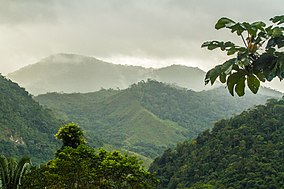Atlantic Forest Biosphere Reserve
| Atlantic Forest Biosphere Reserve | |
|---|---|
| Mata Atlântica Biosphere Reserve | |

Alto Cariri National Park, Guaratinga, Bahia, Brazil
|
|
| Coordinates | 25°23′20″S 48°33′22″W / 25.388872°S 48.556029°WCoordinates: 25°23′20″S 48°33′22″W / 25.388872°S 48.556029°W |
| Area | 62,319,744 hectares (153,995,440 acres) |
| Designation | Biosphere reserve |
| Created | 1991 |
| Administrator |
|
| Website | www |
The Atlantic Forest Biosphere Reserve, or Mata Atlântica Biosphere Reserve (MABR, Portuguese: Reserva da Biosfera da Mata Atlântica) is a biosphere reserve covering remnants of the Atlantic Forest in Brazil, including fully protected and sustainable use conservation units and buffer zones. It is the largest such reserve in the world.
The Atlantic Forest Biosphere Reserve (MABR) extends for 3,000 kilometres (1,900 mi) parallel to the coast of Brazil along the Serra Mantiqueira, Serra Geral and Serra do Mar. from 02°50'S to 33°45'S, and from 34°45'W to 55°15'W. As of 2011 UNESCO reported that the reserve had a total area of 29,473,484 hectares (72,830,570 acres), including core areas of 4,052,544 hectares (10,014,050 acres), buffer zones of 12,646,302 hectares (31,249,690 acres) and transition areas of 12,774,638 hectares (31,566,820 acres). It ranges in altitude from −50 to 2,897 metres (−164 to 9,505 ft) above sea level.
The reserve includes remnants of Atlantic Forest in 15 states, including Minas Gerais, Mato Grosso do Sul, and the coastal states of Ceará, Rio Grande do Norte, Paraíba, Pernambuco, Alagoas, Sergipe, Bahia, Espírito Santo, Rio de Janeiro, São Paulo, Paraná, Santa Catarina and Rio Grande do Sul. As of 2016 the reserve covered parts of over 1,000 municipalities. The surrounding areas had 120 million inhabitants and accounted for 70% of the GDP of Brazil. The core zones consisted of more than 700 fully protected conservation units. A few thousand people lived in the buffer zones, mainly traditional communities of indigenous people, quilombolas, fishermen and so on.
...
Wikipedia

